MBA501 Dynamic Strategy and Disruptive Innovation - Facebook
VerifiedAdded on 2022/10/10
|13
|2156
|274
Report
AI Summary
This report presents a stakeholder analysis of Facebook, examining the various groups and individuals who have an interest in the company's activities and success. It identifies key stakeholders such as the government, customers, employees, developers, investors, suppliers, and communities, detailing their importance and impact on Facebook. The report categorizes these stakeholders into swing, offensive, defensive, and hold categories based on their cooperative potential and competitive threat. It further analyzes their behavior, motives, and potential coalitions, providing insights into how Facebook can effectively manage its relationships with these stakeholders to achieve its strategic objectives. The analysis includes a discussion of the cooperative potential, competitive threat, and actual behavior of each stakeholder group, as well as their objectives, beliefs, and potential for forming coalitions. This detailed examination offers a comprehensive understanding of the stakeholder landscape surrounding Facebook and its implications for the company's future development and success. Desklib offers a wide range of similar solved assignments and past papers for students.
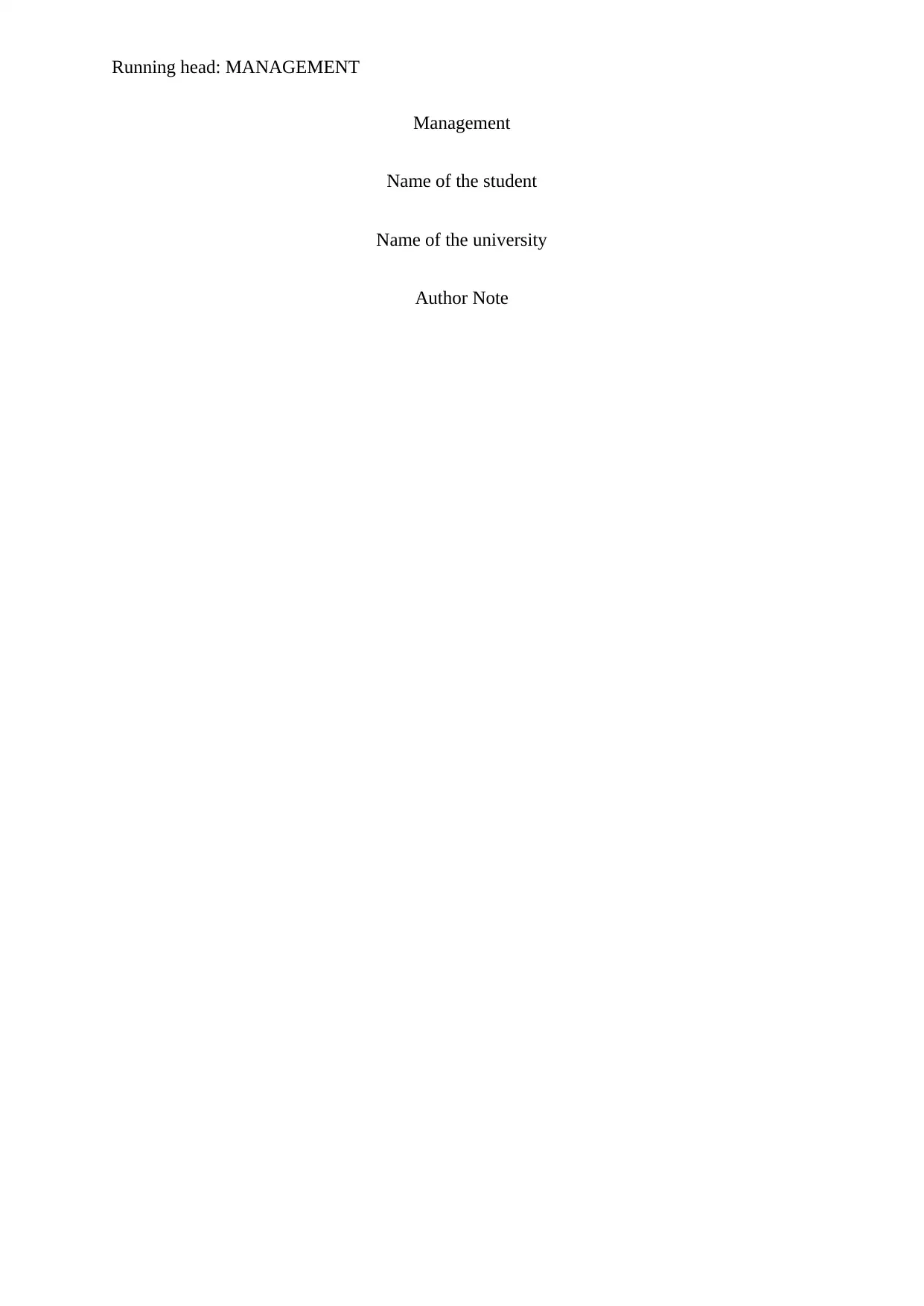
Running head: MANAGEMENT
Management
Name of the student
Name of the university
Author Note
Management
Name of the student
Name of the university
Author Note
Paraphrase This Document
Need a fresh take? Get an instant paraphrase of this document with our AI Paraphraser
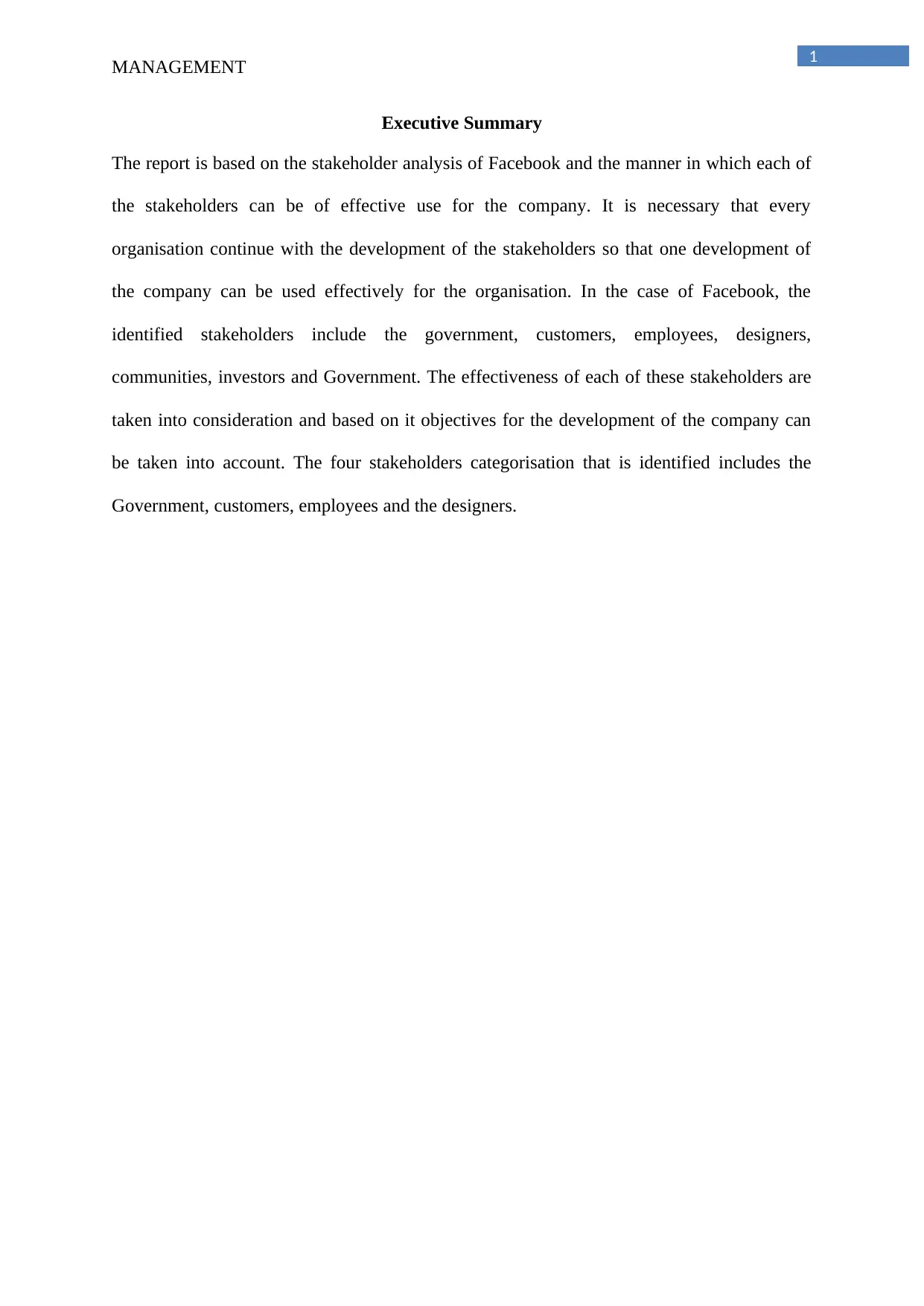
1
MANAGEMENT
Executive Summary
The report is based on the stakeholder analysis of Facebook and the manner in which each of
the stakeholders can be of effective use for the company. It is necessary that every
organisation continue with the development of the stakeholders so that one development of
the company can be used effectively for the organisation. In the case of Facebook, the
identified stakeholders include the government, customers, employees, designers,
communities, investors and Government. The effectiveness of each of these stakeholders are
taken into consideration and based on it objectives for the development of the company can
be taken into account. The four stakeholders categorisation that is identified includes the
Government, customers, employees and the designers.
MANAGEMENT
Executive Summary
The report is based on the stakeholder analysis of Facebook and the manner in which each of
the stakeholders can be of effective use for the company. It is necessary that every
organisation continue with the development of the stakeholders so that one development of
the company can be used effectively for the organisation. In the case of Facebook, the
identified stakeholders include the government, customers, employees, designers,
communities, investors and Government. The effectiveness of each of these stakeholders are
taken into consideration and based on it objectives for the development of the company can
be taken into account. The four stakeholders categorisation that is identified includes the
Government, customers, employees and the designers.
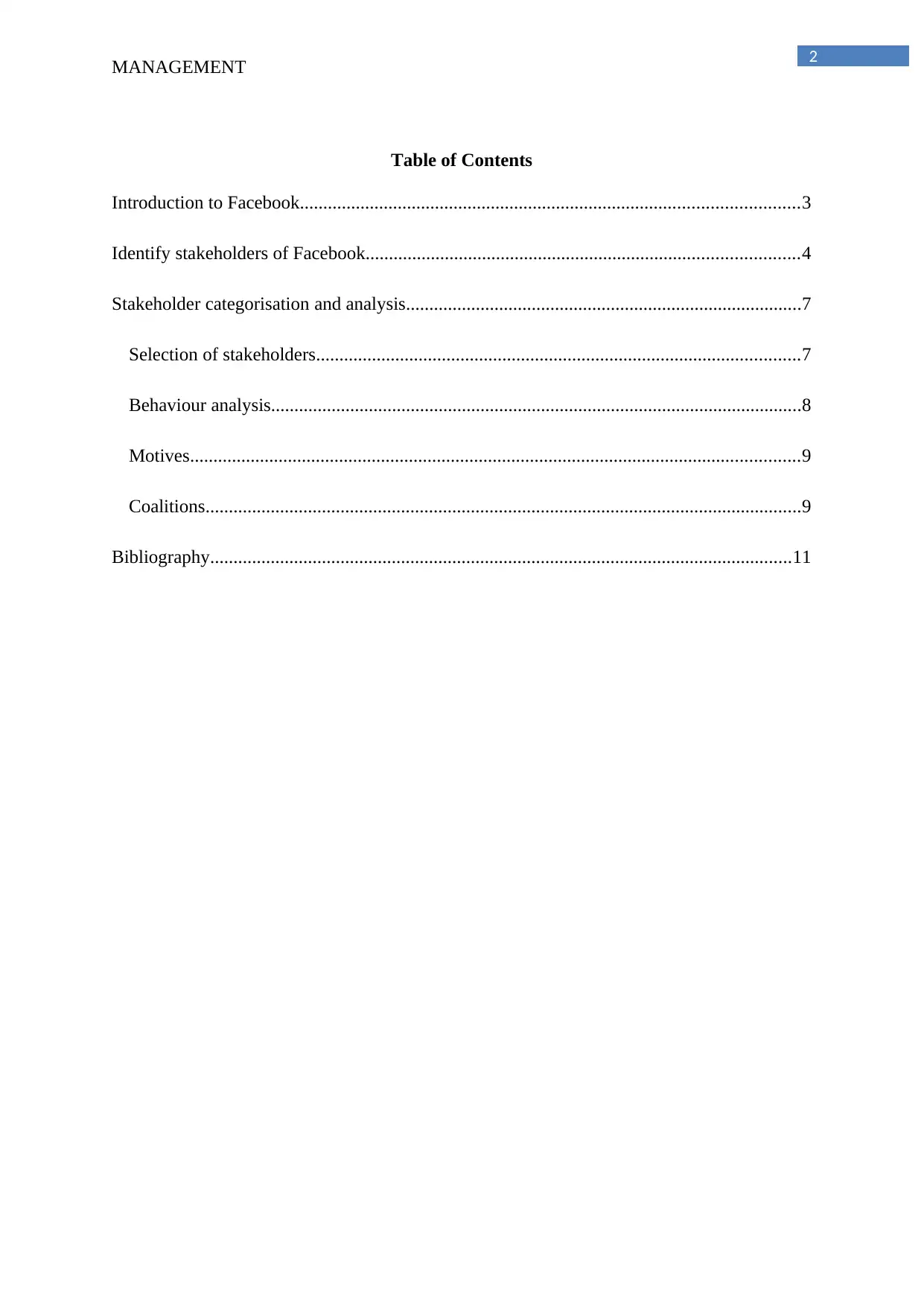
2
MANAGEMENT
Table of Contents
Introduction to Facebook...........................................................................................................3
Identify stakeholders of Facebook.............................................................................................4
Stakeholder categorisation and analysis.....................................................................................7
Selection of stakeholders........................................................................................................7
Behaviour analysis..................................................................................................................8
Motives...................................................................................................................................9
Coalitions................................................................................................................................9
Bibliography.............................................................................................................................11
MANAGEMENT
Table of Contents
Introduction to Facebook...........................................................................................................3
Identify stakeholders of Facebook.............................................................................................4
Stakeholder categorisation and analysis.....................................................................................7
Selection of stakeholders........................................................................................................7
Behaviour analysis..................................................................................................................8
Motives...................................................................................................................................9
Coalitions................................................................................................................................9
Bibliography.............................................................................................................................11
⊘ This is a preview!⊘
Do you want full access?
Subscribe today to unlock all pages.

Trusted by 1+ million students worldwide
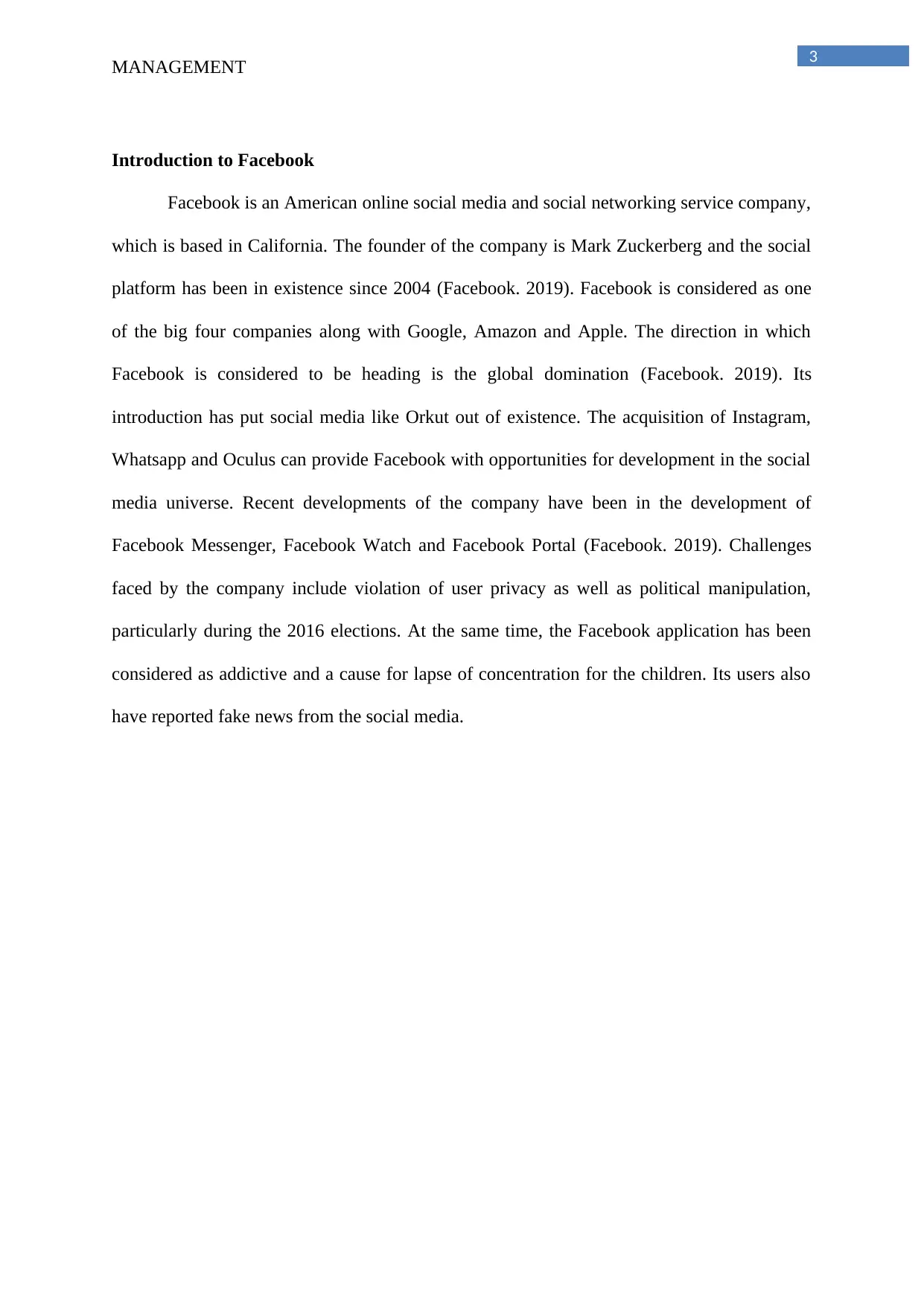
3
MANAGEMENT
Introduction to Facebook
Facebook is an American online social media and social networking service company,
which is based in California. The founder of the company is Mark Zuckerberg and the social
platform has been in existence since 2004 (Facebook. 2019). Facebook is considered as one
of the big four companies along with Google, Amazon and Apple. The direction in which
Facebook is considered to be heading is the global domination (Facebook. 2019). Its
introduction has put social media like Orkut out of existence. The acquisition of Instagram,
Whatsapp and Oculus can provide Facebook with opportunities for development in the social
media universe. Recent developments of the company have been in the development of
Facebook Messenger, Facebook Watch and Facebook Portal (Facebook. 2019). Challenges
faced by the company include violation of user privacy as well as political manipulation,
particularly during the 2016 elections. At the same time, the Facebook application has been
considered as addictive and a cause for lapse of concentration for the children. Its users also
have reported fake news from the social media.
MANAGEMENT
Introduction to Facebook
Facebook is an American online social media and social networking service company,
which is based in California. The founder of the company is Mark Zuckerberg and the social
platform has been in existence since 2004 (Facebook. 2019). Facebook is considered as one
of the big four companies along with Google, Amazon and Apple. The direction in which
Facebook is considered to be heading is the global domination (Facebook. 2019). Its
introduction has put social media like Orkut out of existence. The acquisition of Instagram,
Whatsapp and Oculus can provide Facebook with opportunities for development in the social
media universe. Recent developments of the company have been in the development of
Facebook Messenger, Facebook Watch and Facebook Portal (Facebook. 2019). Challenges
faced by the company include violation of user privacy as well as political manipulation,
particularly during the 2016 elections. At the same time, the Facebook application has been
considered as addictive and a cause for lapse of concentration for the children. Its users also
have reported fake news from the social media.
Paraphrase This Document
Need a fresh take? Get an instant paraphrase of this document with our AI Paraphraser
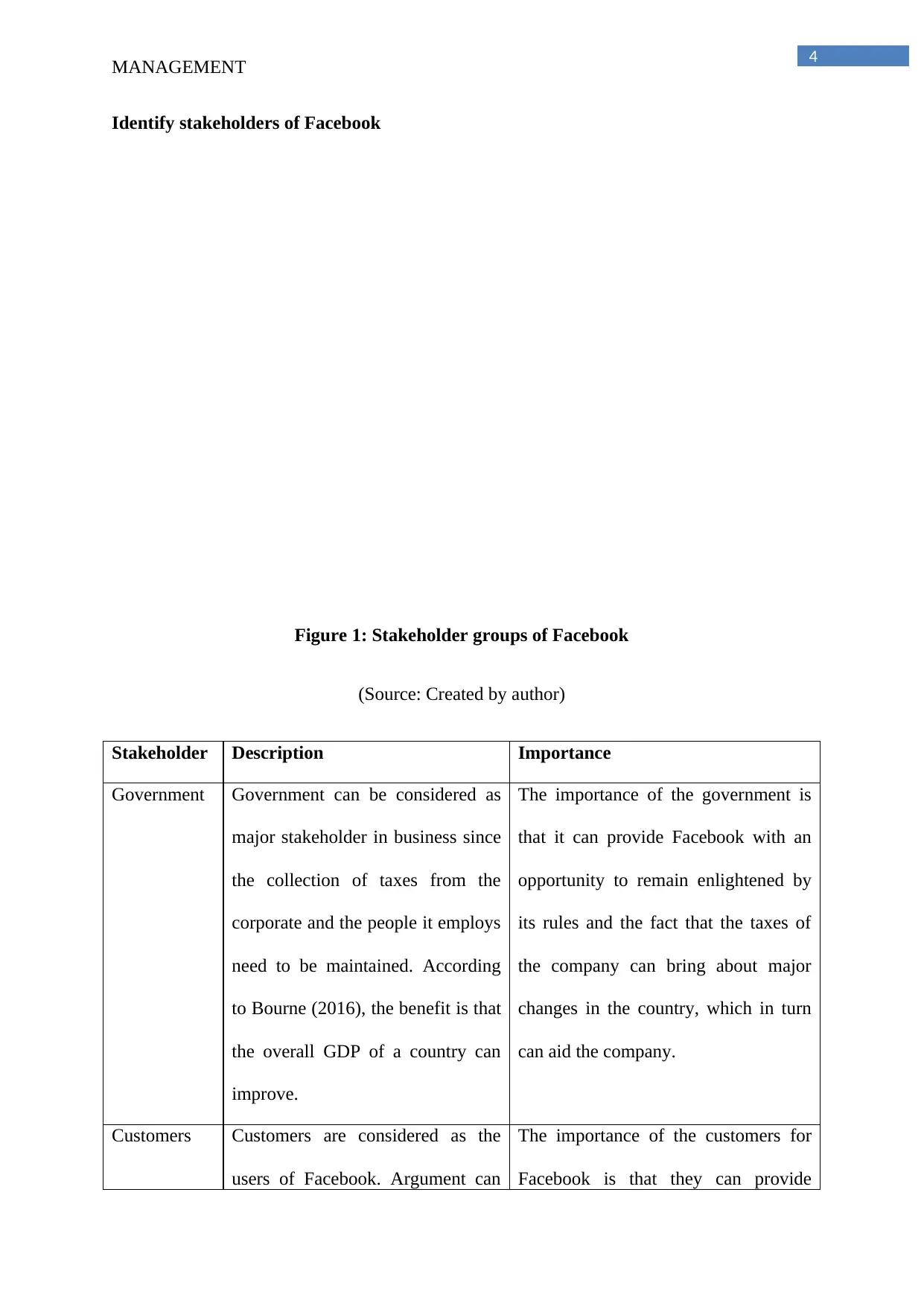
4
MANAGEMENT
Identify stakeholders of Facebook
Figure 1: Stakeholder groups of Facebook
(Source: Created by author)
Stakeholder Description Importance
Government Government can be considered as
major stakeholder in business since
the collection of taxes from the
corporate and the people it employs
need to be maintained. According
to Bourne (2016), the benefit is that
the overall GDP of a country can
improve.
The importance of the government is
that it can provide Facebook with an
opportunity to remain enlightened by
its rules and the fact that the taxes of
the company can bring about major
changes in the country, which in turn
can aid the company.
Customers Customers are considered as the
users of Facebook. Argument can
The importance of the customers for
Facebook is that they can provide
MANAGEMENT
Identify stakeholders of Facebook
Figure 1: Stakeholder groups of Facebook
(Source: Created by author)
Stakeholder Description Importance
Government Government can be considered as
major stakeholder in business since
the collection of taxes from the
corporate and the people it employs
need to be maintained. According
to Bourne (2016), the benefit is that
the overall GDP of a country can
improve.
The importance of the government is
that it can provide Facebook with an
opportunity to remain enlightened by
its rules and the fact that the taxes of
the company can bring about major
changes in the country, which in turn
can aid the company.
Customers Customers are considered as the
users of Facebook. Argument can
The importance of the customers for
Facebook is that they can provide
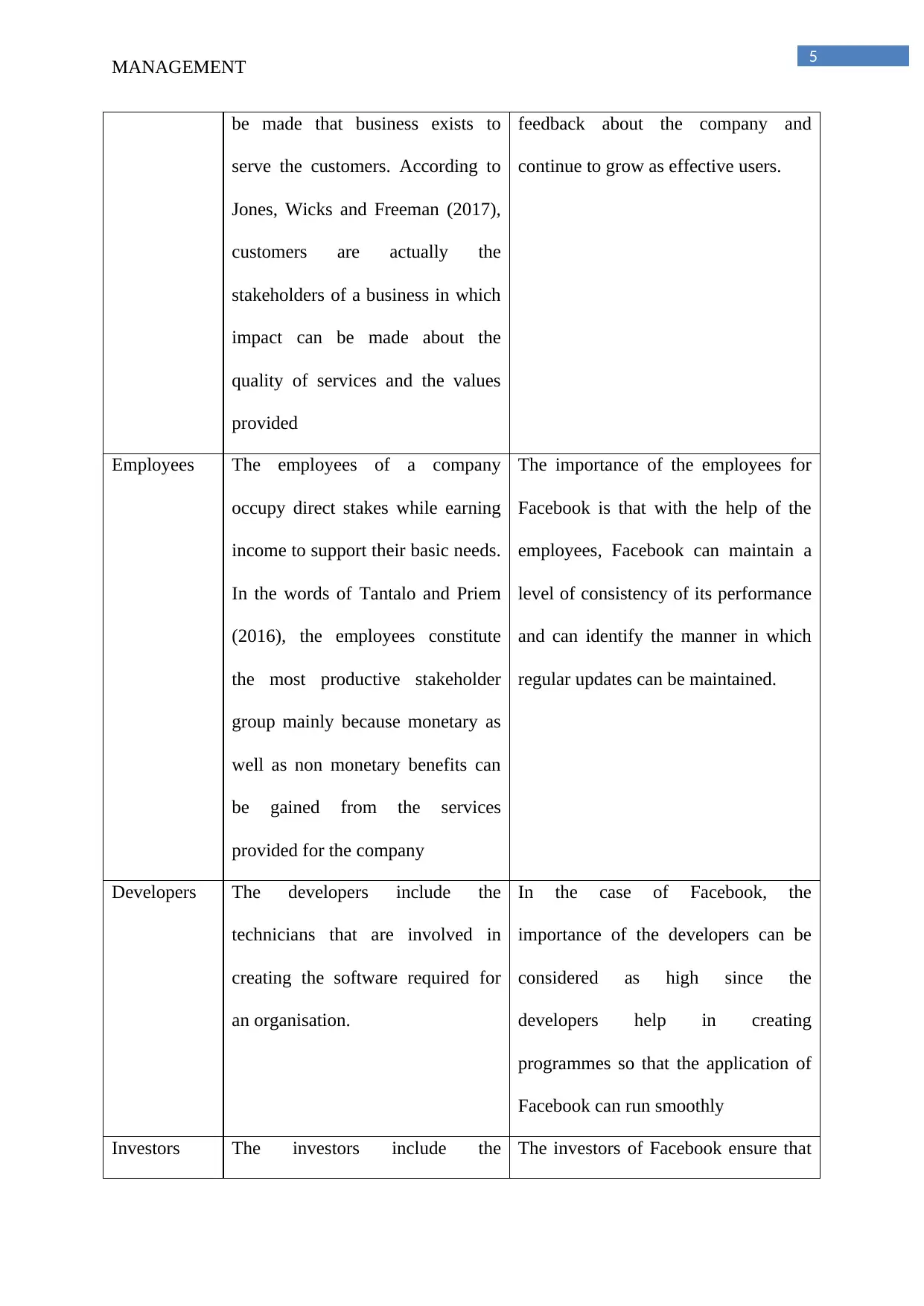
5
MANAGEMENT
be made that business exists to
serve the customers. According to
Jones, Wicks and Freeman (2017),
customers are actually the
stakeholders of a business in which
impact can be made about the
quality of services and the values
provided
feedback about the company and
continue to grow as effective users.
Employees The employees of a company
occupy direct stakes while earning
income to support their basic needs.
In the words of Tantalo and Priem
(2016), the employees constitute
the most productive stakeholder
group mainly because monetary as
well as non monetary benefits can
be gained from the services
provided for the company
The importance of the employees for
Facebook is that with the help of the
employees, Facebook can maintain a
level of consistency of its performance
and can identify the manner in which
regular updates can be maintained.
Developers The developers include the
technicians that are involved in
creating the software required for
an organisation.
In the case of Facebook, the
importance of the developers can be
considered as high since the
developers help in creating
programmes so that the application of
Facebook can run smoothly
Investors The investors include the The investors of Facebook ensure that
MANAGEMENT
be made that business exists to
serve the customers. According to
Jones, Wicks and Freeman (2017),
customers are actually the
stakeholders of a business in which
impact can be made about the
quality of services and the values
provided
feedback about the company and
continue to grow as effective users.
Employees The employees of a company
occupy direct stakes while earning
income to support their basic needs.
In the words of Tantalo and Priem
(2016), the employees constitute
the most productive stakeholder
group mainly because monetary as
well as non monetary benefits can
be gained from the services
provided for the company
The importance of the employees for
Facebook is that with the help of the
employees, Facebook can maintain a
level of consistency of its performance
and can identify the manner in which
regular updates can be maintained.
Developers The developers include the
technicians that are involved in
creating the software required for
an organisation.
In the case of Facebook, the
importance of the developers can be
considered as high since the
developers help in creating
programmes so that the application of
Facebook can run smoothly
Investors The investors include the The investors of Facebook ensure that
⊘ This is a preview!⊘
Do you want full access?
Subscribe today to unlock all pages.

Trusted by 1+ million students worldwide
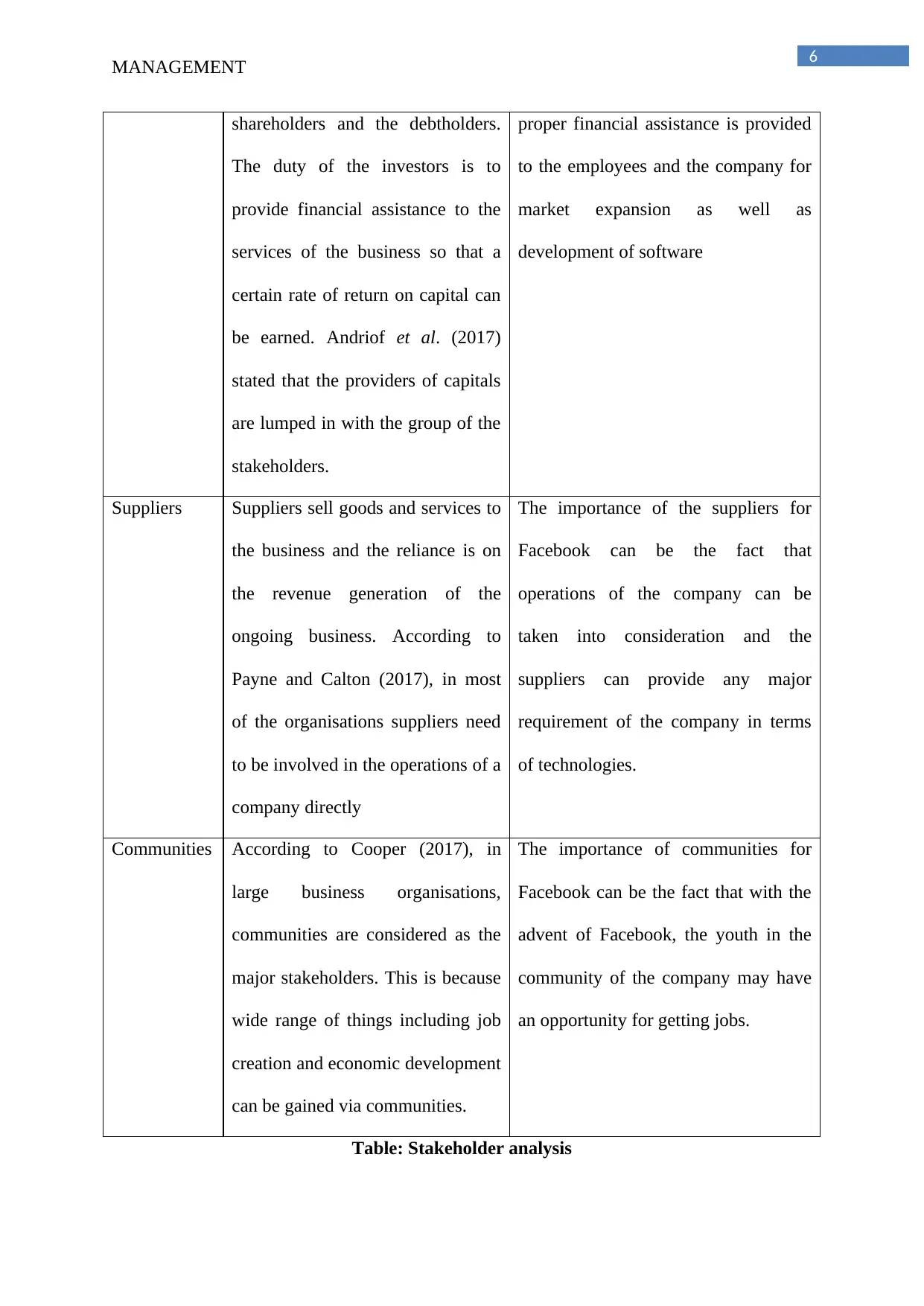
6
MANAGEMENT
shareholders and the debtholders.
The duty of the investors is to
provide financial assistance to the
services of the business so that a
certain rate of return on capital can
be earned. Andriof et al. (2017)
stated that the providers of capitals
are lumped in with the group of the
stakeholders.
proper financial assistance is provided
to the employees and the company for
market expansion as well as
development of software
Suppliers Suppliers sell goods and services to
the business and the reliance is on
the revenue generation of the
ongoing business. According to
Payne and Calton (2017), in most
of the organisations suppliers need
to be involved in the operations of a
company directly
The importance of the suppliers for
Facebook can be the fact that
operations of the company can be
taken into consideration and the
suppliers can provide any major
requirement of the company in terms
of technologies.
Communities According to Cooper (2017), in
large business organisations,
communities are considered as the
major stakeholders. This is because
wide range of things including job
creation and economic development
can be gained via communities.
The importance of communities for
Facebook can be the fact that with the
advent of Facebook, the youth in the
community of the company may have
an opportunity for getting jobs.
Table: Stakeholder analysis
MANAGEMENT
shareholders and the debtholders.
The duty of the investors is to
provide financial assistance to the
services of the business so that a
certain rate of return on capital can
be earned. Andriof et al. (2017)
stated that the providers of capitals
are lumped in with the group of the
stakeholders.
proper financial assistance is provided
to the employees and the company for
market expansion as well as
development of software
Suppliers Suppliers sell goods and services to
the business and the reliance is on
the revenue generation of the
ongoing business. According to
Payne and Calton (2017), in most
of the organisations suppliers need
to be involved in the operations of a
company directly
The importance of the suppliers for
Facebook can be the fact that
operations of the company can be
taken into consideration and the
suppliers can provide any major
requirement of the company in terms
of technologies.
Communities According to Cooper (2017), in
large business organisations,
communities are considered as the
major stakeholders. This is because
wide range of things including job
creation and economic development
can be gained via communities.
The importance of communities for
Facebook can be the fact that with the
advent of Facebook, the youth in the
community of the company may have
an opportunity for getting jobs.
Table: Stakeholder analysis
Paraphrase This Document
Need a fresh take? Get an instant paraphrase of this document with our AI Paraphraser
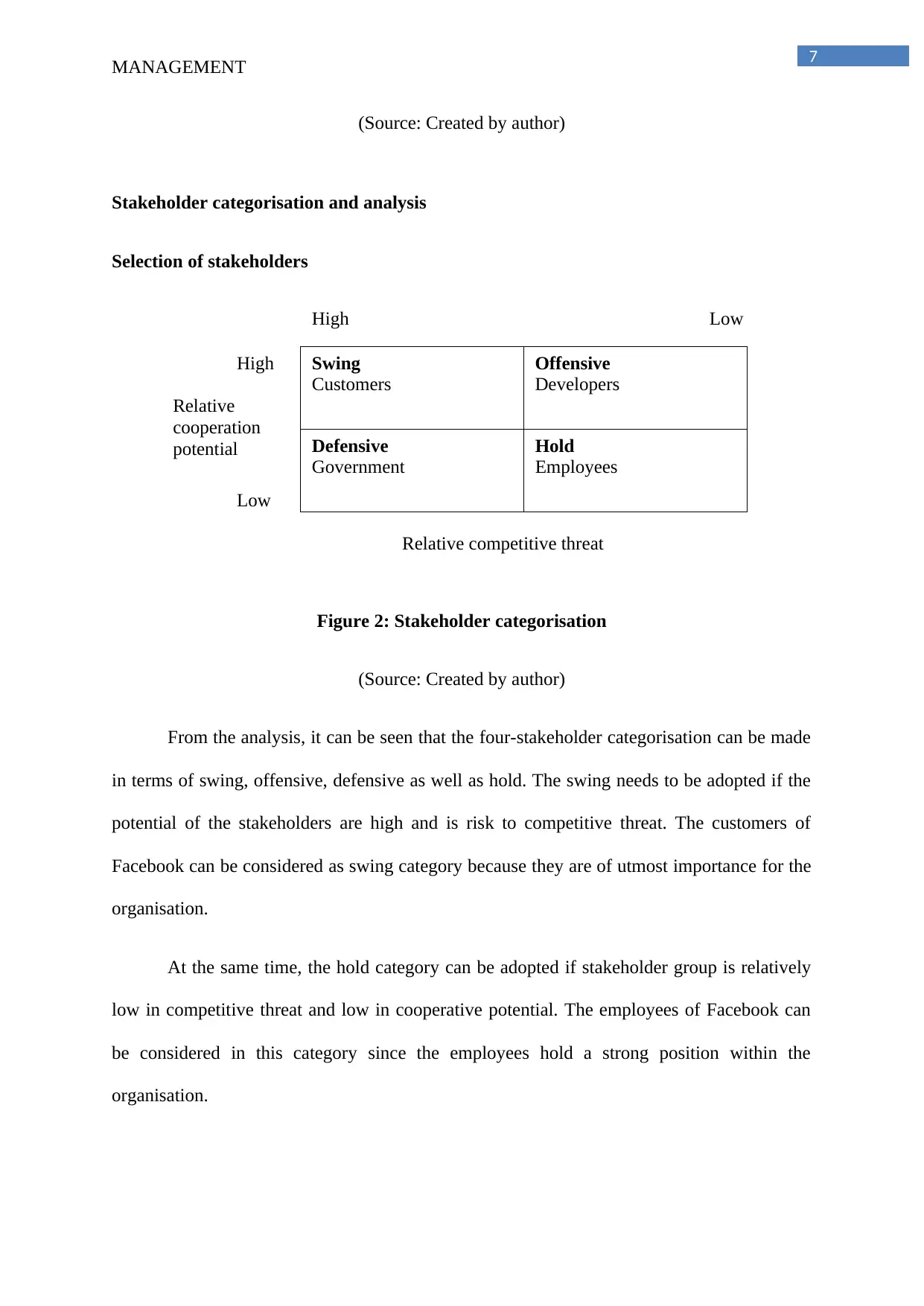
7
Swing
Customers
Hold
Employees
Offensive
Developers
Defensive
Government
High
High
Low
Low
Relative competitive threat
Relative
cooperation
potential
MANAGEMENT
(Source: Created by author)
Stakeholder categorisation and analysis
Selection of stakeholders
Figure 2: Stakeholder categorisation
(Source: Created by author)
From the analysis, it can be seen that the four-stakeholder categorisation can be made
in terms of swing, offensive, defensive as well as hold. The swing needs to be adopted if the
potential of the stakeholders are high and is risk to competitive threat. The customers of
Facebook can be considered as swing category because they are of utmost importance for the
organisation.
At the same time, the hold category can be adopted if stakeholder group is relatively
low in competitive threat and low in cooperative potential. The employees of Facebook can
be considered in this category since the employees hold a strong position within the
organisation.
Swing
Customers
Hold
Employees
Offensive
Developers
Defensive
Government
High
High
Low
Low
Relative competitive threat
Relative
cooperation
potential
MANAGEMENT
(Source: Created by author)
Stakeholder categorisation and analysis
Selection of stakeholders
Figure 2: Stakeholder categorisation
(Source: Created by author)
From the analysis, it can be seen that the four-stakeholder categorisation can be made
in terms of swing, offensive, defensive as well as hold. The swing needs to be adopted if the
potential of the stakeholders are high and is risk to competitive threat. The customers of
Facebook can be considered as swing category because they are of utmost importance for the
organisation.
At the same time, the hold category can be adopted if stakeholder group is relatively
low in competitive threat and low in cooperative potential. The employees of Facebook can
be considered in this category since the employees hold a strong position within the
organisation.
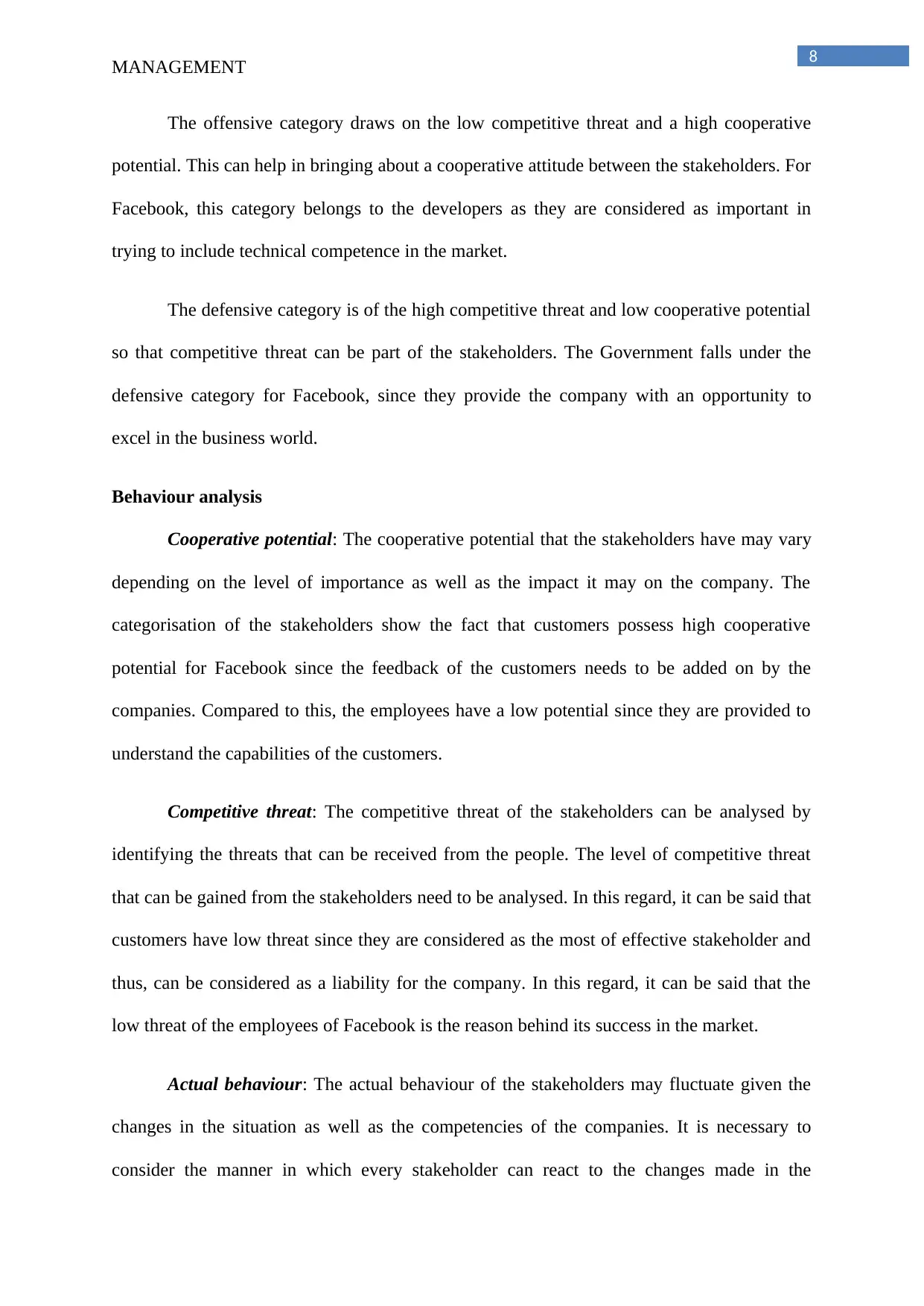
8
MANAGEMENT
The offensive category draws on the low competitive threat and a high cooperative
potential. This can help in bringing about a cooperative attitude between the stakeholders. For
Facebook, this category belongs to the developers as they are considered as important in
trying to include technical competence in the market.
The defensive category is of the high competitive threat and low cooperative potential
so that competitive threat can be part of the stakeholders. The Government falls under the
defensive category for Facebook, since they provide the company with an opportunity to
excel in the business world.
Behaviour analysis
Cooperative potential: The cooperative potential that the stakeholders have may vary
depending on the level of importance as well as the impact it may on the company. The
categorisation of the stakeholders show the fact that customers possess high cooperative
potential for Facebook since the feedback of the customers needs to be added on by the
companies. Compared to this, the employees have a low potential since they are provided to
understand the capabilities of the customers.
Competitive threat: The competitive threat of the stakeholders can be analysed by
identifying the threats that can be received from the people. The level of competitive threat
that can be gained from the stakeholders need to be analysed. In this regard, it can be said that
customers have low threat since they are considered as the most of effective stakeholder and
thus, can be considered as a liability for the company. In this regard, it can be said that the
low threat of the employees of Facebook is the reason behind its success in the market.
Actual behaviour: The actual behaviour of the stakeholders may fluctuate given the
changes in the situation as well as the competencies of the companies. It is necessary to
consider the manner in which every stakeholder can react to the changes made in the
MANAGEMENT
The offensive category draws on the low competitive threat and a high cooperative
potential. This can help in bringing about a cooperative attitude between the stakeholders. For
Facebook, this category belongs to the developers as they are considered as important in
trying to include technical competence in the market.
The defensive category is of the high competitive threat and low cooperative potential
so that competitive threat can be part of the stakeholders. The Government falls under the
defensive category for Facebook, since they provide the company with an opportunity to
excel in the business world.
Behaviour analysis
Cooperative potential: The cooperative potential that the stakeholders have may vary
depending on the level of importance as well as the impact it may on the company. The
categorisation of the stakeholders show the fact that customers possess high cooperative
potential for Facebook since the feedback of the customers needs to be added on by the
companies. Compared to this, the employees have a low potential since they are provided to
understand the capabilities of the customers.
Competitive threat: The competitive threat of the stakeholders can be analysed by
identifying the threats that can be received from the people. The level of competitive threat
that can be gained from the stakeholders need to be analysed. In this regard, it can be said that
customers have low threat since they are considered as the most of effective stakeholder and
thus, can be considered as a liability for the company. In this regard, it can be said that the
low threat of the employees of Facebook is the reason behind its success in the market.
Actual behaviour: The actual behaviour of the stakeholders may fluctuate given the
changes in the situation as well as the competencies of the companies. It is necessary to
consider the manner in which every stakeholder can react to the changes made in the
⊘ This is a preview!⊘
Do you want full access?
Subscribe today to unlock all pages.

Trusted by 1+ million students worldwide
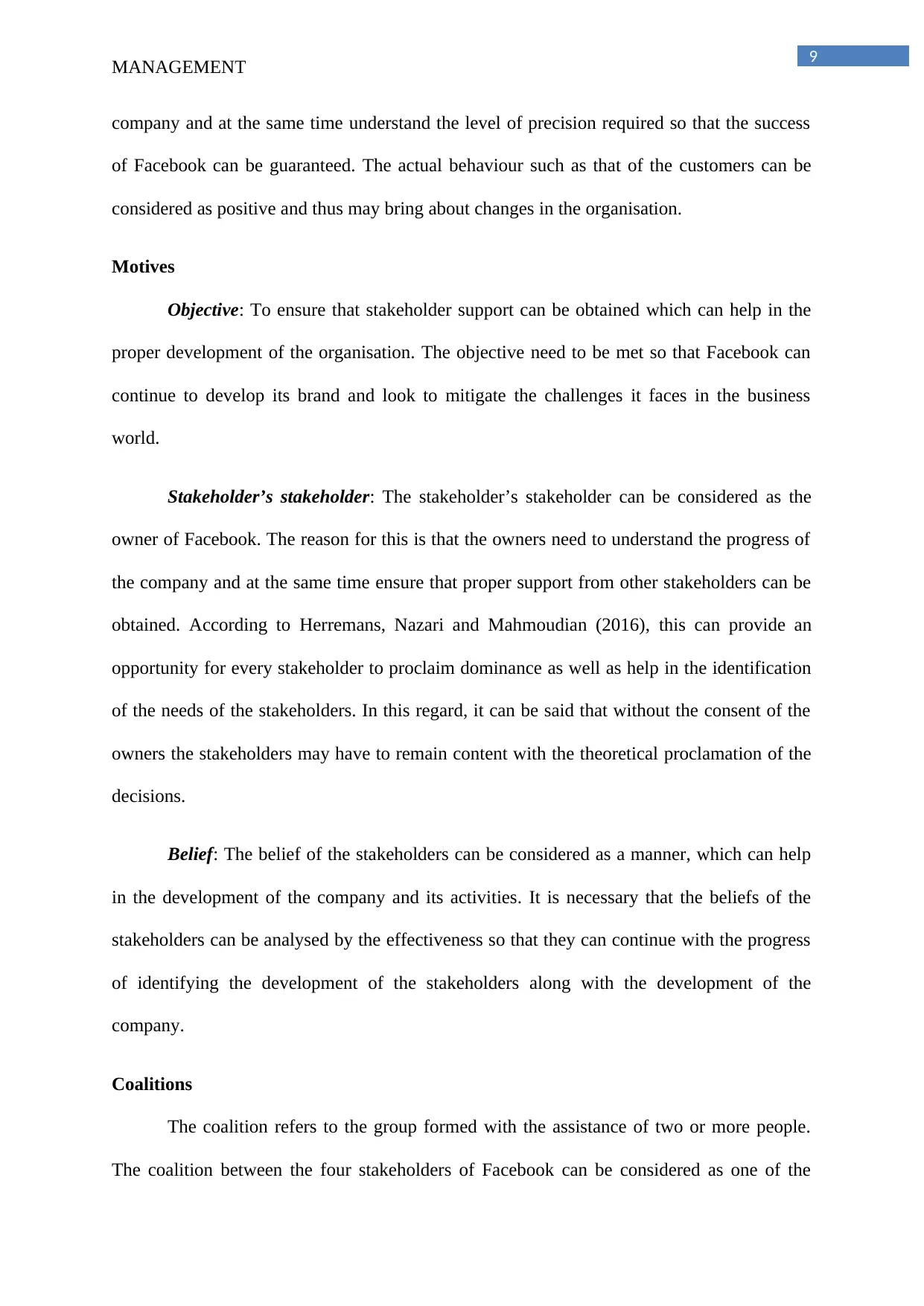
9
MANAGEMENT
company and at the same time understand the level of precision required so that the success
of Facebook can be guaranteed. The actual behaviour such as that of the customers can be
considered as positive and thus may bring about changes in the organisation.
Motives
Objective: To ensure that stakeholder support can be obtained which can help in the
proper development of the organisation. The objective need to be met so that Facebook can
continue to develop its brand and look to mitigate the challenges it faces in the business
world.
Stakeholder’s stakeholder: The stakeholder’s stakeholder can be considered as the
owner of Facebook. The reason for this is that the owners need to understand the progress of
the company and at the same time ensure that proper support from other stakeholders can be
obtained. According to Herremans, Nazari and Mahmoudian (2016), this can provide an
opportunity for every stakeholder to proclaim dominance as well as help in the identification
of the needs of the stakeholders. In this regard, it can be said that without the consent of the
owners the stakeholders may have to remain content with the theoretical proclamation of the
decisions.
Belief: The belief of the stakeholders can be considered as a manner, which can help
in the development of the company and its activities. It is necessary that the beliefs of the
stakeholders can be analysed by the effectiveness so that they can continue with the progress
of identifying the development of the stakeholders along with the development of the
company.
Coalitions
The coalition refers to the group formed with the assistance of two or more people.
The coalition between the four stakeholders of Facebook can be considered as one of the
MANAGEMENT
company and at the same time understand the level of precision required so that the success
of Facebook can be guaranteed. The actual behaviour such as that of the customers can be
considered as positive and thus may bring about changes in the organisation.
Motives
Objective: To ensure that stakeholder support can be obtained which can help in the
proper development of the organisation. The objective need to be met so that Facebook can
continue to develop its brand and look to mitigate the challenges it faces in the business
world.
Stakeholder’s stakeholder: The stakeholder’s stakeholder can be considered as the
owner of Facebook. The reason for this is that the owners need to understand the progress of
the company and at the same time ensure that proper support from other stakeholders can be
obtained. According to Herremans, Nazari and Mahmoudian (2016), this can provide an
opportunity for every stakeholder to proclaim dominance as well as help in the identification
of the needs of the stakeholders. In this regard, it can be said that without the consent of the
owners the stakeholders may have to remain content with the theoretical proclamation of the
decisions.
Belief: The belief of the stakeholders can be considered as a manner, which can help
in the development of the company and its activities. It is necessary that the beliefs of the
stakeholders can be analysed by the effectiveness so that they can continue with the progress
of identifying the development of the stakeholders along with the development of the
company.
Coalitions
The coalition refers to the group formed with the assistance of two or more people.
The coalition between the four stakeholders of Facebook can be considered as one of the
Paraphrase This Document
Need a fresh take? Get an instant paraphrase of this document with our AI Paraphraser
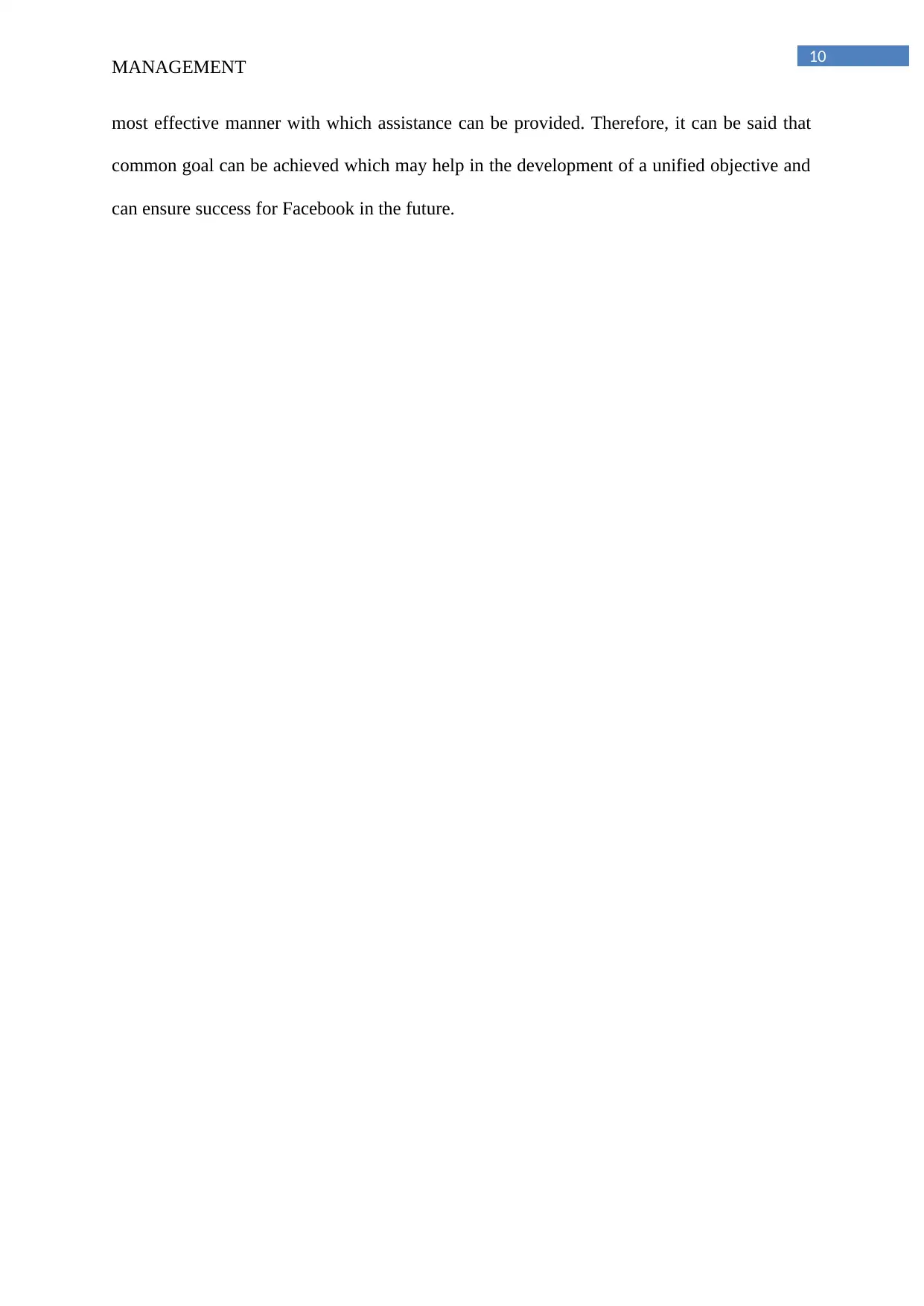
10
MANAGEMENT
most effective manner with which assistance can be provided. Therefore, it can be said that
common goal can be achieved which may help in the development of a unified objective and
can ensure success for Facebook in the future.
MANAGEMENT
most effective manner with which assistance can be provided. Therefore, it can be said that
common goal can be achieved which may help in the development of a unified objective and
can ensure success for Facebook in the future.
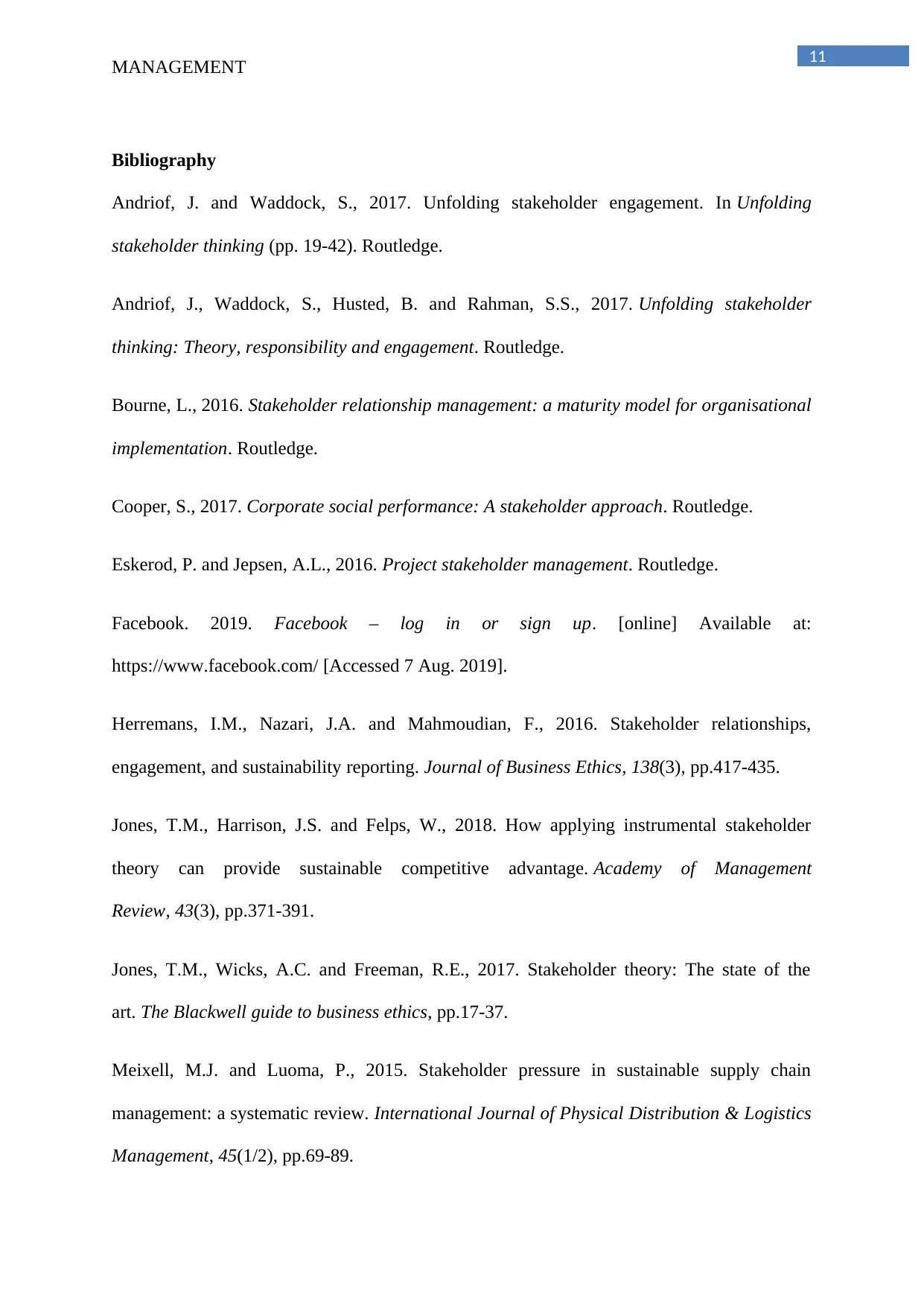
11
MANAGEMENT
Bibliography
Andriof, J. and Waddock, S., 2017. Unfolding stakeholder engagement. In Unfolding
stakeholder thinking (pp. 19-42). Routledge.
Andriof, J., Waddock, S., Husted, B. and Rahman, S.S., 2017. Unfolding stakeholder
thinking: Theory, responsibility and engagement. Routledge.
Bourne, L., 2016. Stakeholder relationship management: a maturity model for organisational
implementation. Routledge.
Cooper, S., 2017. Corporate social performance: A stakeholder approach. Routledge.
Eskerod, P. and Jepsen, A.L., 2016. Project stakeholder management. Routledge.
Facebook. 2019. Facebook – log in or sign up. [online] Available at:
https://www.facebook.com/ [Accessed 7 Aug. 2019].
Herremans, I.M., Nazari, J.A. and Mahmoudian, F., 2016. Stakeholder relationships,
engagement, and sustainability reporting. Journal of Business Ethics, 138(3), pp.417-435.
Jones, T.M., Harrison, J.S. and Felps, W., 2018. How applying instrumental stakeholder
theory can provide sustainable competitive advantage. Academy of Management
Review, 43(3), pp.371-391.
Jones, T.M., Wicks, A.C. and Freeman, R.E., 2017. Stakeholder theory: The state of the
art. The Blackwell guide to business ethics, pp.17-37.
Meixell, M.J. and Luoma, P., 2015. Stakeholder pressure in sustainable supply chain
management: a systematic review. International Journal of Physical Distribution & Logistics
Management, 45(1/2), pp.69-89.
MANAGEMENT
Bibliography
Andriof, J. and Waddock, S., 2017. Unfolding stakeholder engagement. In Unfolding
stakeholder thinking (pp. 19-42). Routledge.
Andriof, J., Waddock, S., Husted, B. and Rahman, S.S., 2017. Unfolding stakeholder
thinking: Theory, responsibility and engagement. Routledge.
Bourne, L., 2016. Stakeholder relationship management: a maturity model for organisational
implementation. Routledge.
Cooper, S., 2017. Corporate social performance: A stakeholder approach. Routledge.
Eskerod, P. and Jepsen, A.L., 2016. Project stakeholder management. Routledge.
Facebook. 2019. Facebook – log in or sign up. [online] Available at:
https://www.facebook.com/ [Accessed 7 Aug. 2019].
Herremans, I.M., Nazari, J.A. and Mahmoudian, F., 2016. Stakeholder relationships,
engagement, and sustainability reporting. Journal of Business Ethics, 138(3), pp.417-435.
Jones, T.M., Harrison, J.S. and Felps, W., 2018. How applying instrumental stakeholder
theory can provide sustainable competitive advantage. Academy of Management
Review, 43(3), pp.371-391.
Jones, T.M., Wicks, A.C. and Freeman, R.E., 2017. Stakeholder theory: The state of the
art. The Blackwell guide to business ethics, pp.17-37.
Meixell, M.J. and Luoma, P., 2015. Stakeholder pressure in sustainable supply chain
management: a systematic review. International Journal of Physical Distribution & Logistics
Management, 45(1/2), pp.69-89.
⊘ This is a preview!⊘
Do you want full access?
Subscribe today to unlock all pages.

Trusted by 1+ million students worldwide
1 out of 13
Related Documents
Your All-in-One AI-Powered Toolkit for Academic Success.
+13062052269
info@desklib.com
Available 24*7 on WhatsApp / Email
![[object Object]](/_next/static/media/star-bottom.7253800d.svg)
Unlock your academic potential
Copyright © 2020–2025 A2Z Services. All Rights Reserved. Developed and managed by ZUCOL.





